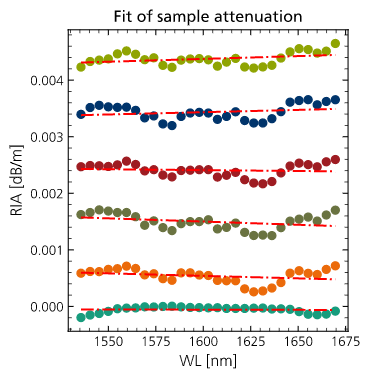Investigating the radiation effect on a component of the MERLIN instrument
Authors: Dr. Jochen Kuhnhenn, Wolfram Berky
The MERLIN satellite ("Methane Remote Sensing LIDAR Mission") uses a differential LIDARo ("Light Detection And Ranging") to globally measure the spatial and temporal concentration of methane in the atmosphere. The LIDAR operates in the nadir direction at a wavelength of 1645.55 nm. At this wavelength, methane has transitions of suitable absorption and width to allow differential absorption analysis. For this purpose, two laser pulses with slightly different wavelengths are repeatedly emitted. At the first wavelength, absorption by methane occurs, and the signals from the second serve as a reference of other absorptions in the atmosphere. Evaluation of the difference between the backscattered light signals provides the absolute methane concentration. Crucial for the precision of the measurements is the knowledge of the two wavelengths as well as the accuracy of the relative pulse energies over the entire expected dynamic range.
A critical component for this analysis is an optical fiber in the instrument’s calibration system, which transmits the signals of both wavelengths. As the concentration of methane can be determined from the difference between the reference and absorption wavelength signals, significant spectral changes to the transmission properties of the optical fiber must not occur during the mission.
Possible interference can occur as a result of the fiber’s exposure to radiation in space, for example. It has been known for a long time that this affects light transmission in optical media. This depends, in particular, on the light’s wavelength. If space radiation damaged the optical fiber in the MERLIN instrument, causing both wavelengths to experience different attenuation, this would affect the accuracy of the measurements or even make it impossible to obtain readings.
Fraunhofer INT was therefore commissioned by Airbus Defense and Space to conduct a study on the expected effects.
A particular challenge facing this analysis was the fact that even the smallest effects can have an impact on the mission application. The scale of the tolerable change in transmission between both wavelengths is only approx. 10-4. To complicate matters further, the different effect that must be detected for both wavelengths is very small and the fundamental effect of the attenuation increase in a comparatively short trial is only small.
The project’s task was thus to develop a highly sensitive but stable setup that is above all designed for wavelength dependency. A combination of a white light source and spectrometer was used; the latter was particularly sensitive in the near-infrared range that was the focus of the investigation.
In several steps, different variants of the measurement setup were initially validated and tested to see whether the detection capability would be sufficient to supply the required data. In the next preliminary test, samples of different glass fibers were subsequently irradiated to calculate suitable parameters for dose, dose rate and sample length, for example. After finally determining the conditions, a sample of the glass fiber was provided for the actual test performed by Airbus DS; this sample will also be used in the calibration system of the MERLIN instrument.
In the evaluation of this irradiation, it was finally proven that the expected negative effect on the glass fiber intended for the project will be below the critical values for the mission by at least a factor of 10. There is thus nothing standing in the way of the planned implementation. In contrast, in another irradiation experiment conducted to compare another glass fiber sample, it was demonstrated that the effect on the glass fiber was significant and this would have excluded its use for MERLIN.
Acknowledgment: The German part of the MERLIN project is funded by the German Federal Ministry for Economic Affairs and Energy under DLR (German Aerospace Center) grant 50 EP 1601.
 Fraunhofer Institute for Technological Trend Analysis INT
Fraunhofer Institute for Technological Trend Analysis INT